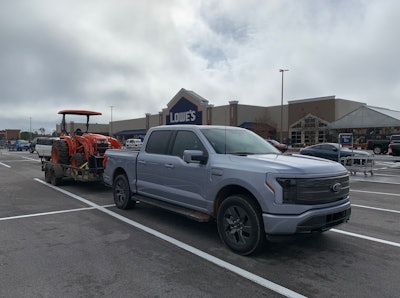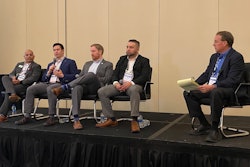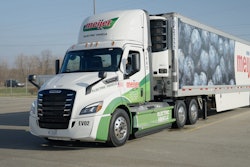
The long, slow march into all-electric trucks is underway and if my recent 1,000-mile test drive in the Ford F-150 Lighting is any indication, there’s a lot of impressive things these battery-powered workhorses can do – and there’s a lot more that needs to be done in terms of making a smooth transition into the demanding world of commercial fleets.
First of all, we need more data, which means OEMs need to get more electric trucks and vans into the hands of reporters and fleets alike for testing.
On that note, it was good to hear that two Freightliner eCascadias recently made their way to the cold North to join the fleet at Meijer, a longtime retailer based in Grand Rapids, Michigan.
Keep in mind that up until now, eCascadias have been operating in California in areas where temperatures are typically mild. But in Grand Rapids? Here the Class 8 electrics will be up against much colder weather. The average temperature there in January last year was a chilling 28°F according to the National Weather Service.
Data from reporters and EV owners has already shown that freezing temperatures significantly impact lithium-ion battery pack performance. But as the Department of Energy pointed out, most range lost in freezing temperatures (in this case 20°F fuel economy testing) was owed to HVAC use.
“For electric vehicles (EVs), fuel economy can drop roughly 39% in mixed city and highway driving, and range can drop by 41%,” the DOE article Fuel Economy in Cold Weather states. “About two-thirds of the extra energy consumed is used to heat the cabin. When the cabin heater is not used, EV fuel economy is 8% lower at 20°F than at 75°F. Driving range is about 12% lower.”
[Related: Fuel groups say Biden's plans to go green undermine trucking's emissions reduction efforts]
An 8% drop in fuel economy in freezing weather is not too bad relative to 20°F impact on gasoline-fueled vehicles which the DOE said “suffer a 10% to 20% fuel economy loss in city driving and a 15% to 33% loss on short trips.”
Of course, those driving those internal combustion vehicles were nice and toasty thanks to their heaters, which make use of heat energy generated by those engines.
So how are Meijer’s eCascadias and their drivers faring thus far? While Meijer’s director of Outbound Logistics, David Hoover, told me that they’ll need more time to really nail down cold weather performance, charging, driver acceptance and so much more, he’s pleased with their initial results.
“These tractors are the most comfortable ride I’ve had in a semi,” Hoover said. “We are starting to get some learnings; for example, regenerative braking extending the range and how best to operate. We are currently spending a lot of time training for both maintenance and drivers along with our dealership support.”
Of course, I’m curious to get more of Hoover’s impressions in the months ahead. So far we share the same enthusiasm over ride quality and brake regen.
Following that 1,000-mile review with the 2022 Ford F-150 Lightning, I walked away thinking it was the most comfortable pickup I had driven (particularly while towing) and that brake regen through one-pedal driving in heavy city traffic and hands-free driving with BlueCruise through traffic jams on two interstates was pretty amazing. After all, brake regen generates electricity for the battery during all those stop and go moments while preserving the brakes.
Highway miles, however, were not so good. A 101-mile trip from Panama City, Florida, to Tallahassee cost us 141 miles in range. Where’d that 40 miles go? Good question.
[Related: Cold temperatures are depleting EV batteries]
Using Lightning’s route planner, the truck knew that save for a few miles of city traffic, I would be traveling mostly on highway yet the range remained at 267 miles when we began the first leg of that roughly 800-mile trip.
When I plugged in our flatbed trailer to haul the Kubota tractor (a 7,000 lb. load) and entered trailer dimensions and its 10,000 lb. GVWR, Lightning dropped from 288 miles of range to 164 for a total loss of 124 miles.
I’ve lost half my fuel economy while towing with internal combustion pickups so that wasn’t a surprise. This was actually a little better. However, after seven miles into the trip, Lightning’s math went to work again and we ended up with 115 miles to empty.
All told, we ended up with roughly 124 miles to tow 7,000 lbs., which was 3,000 lbs. shy of this Lightning Lariat’s max towing of 10,000 lbs. with the extended range battery.
In addition to periodic and mostly disappointing range recalculations, I could never charge the truck up to its advertised 320 miles of range. The best I could do on a slow AC overnight charge – which brought the truck to a 100% charge – was 288 miles. That’s only five more miles than my prior best of 283 miles at a 90% charge through DC fast-charging.
One of the best perks of the truck was its low price to fuel up on AC overnight charging. It cost $8.50 to take it from 50 to a 100% charge. Unfortunately, DC fast-charging costs roughly triple that amount.
Having more precise torque control at all four wheels is pretty amazing as well. While traveling west bound from Jacksonville on Interstate 10, a pickup in front of me lost its ladder. I had to swerve fast to keep from hitting it and aside from a slight tire bark, the truck maintained its composure and kept us safe. I remain completely impressed.
While I had no issues charging at home from a 220-volt outlet, charging on the road was not as convenient. Keep in mind that while charging at home I was mostly doing it overnight when the truck wouldn’t have been used anyway. On a long road trip, waiting 45 minutes to charge up is a hassle unless you happen to time out breakfast, lunch or dinner while the truck is charging. We managed to pull that off once.
Regarding DC fast-charging with tractor-trailers, I’ve heard similar stories. As long as you can time it out with a meal, rest break or do it overnight when the truck’s not being used, it’s no big deal.
Of course life doesn’t always play so nice and that’s why to my earlier point, we need more time with all-electric trucks and vans to see where they can really shine and where they should be truly avoided.
If Meijer and other companies can pull it off, great. Electrics can save an awful lot in fuel and maintenance costs in addition to eliminating emissions. But if they stray outside their comfort zone and are pushed too hard, these trucks will generate a lot of tough headlines and make a lot of people wonder if they were pushed into the market way too soon, which will make it tougher for more improved EV generations to come.












